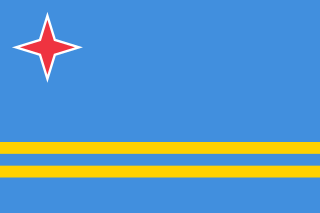
Bonaire is an island in the Leeward Antilles in the Caribbean Sea. Its capital is Kralendijk, located near the ocean on the lee side of the island. Aruba, Bonaire and Curaçao form the ABC islands located 80 km off the coast of Venezuela. Unlike much of the Caribbean region, the ABC islands lie outside Hurricane Alley. The islands have an arid climate that attracts visitors seeking warm, sunny weather year round. Bonaire is a popular snorkeling and scuba diving destination because of its multiple shore diving sites and easy access to the island's fringing reefs.
The Constitution of the Netherlands Antilles was proclaimed on 29 March 1955 by Order-in-Council for the Kingdom. Its proclamation was specifically mandated by article 59(4) of the Charter for the Kingdom of the Netherlands, which had been enacted on 15 December 1954. Together with the Island Regulation of the Netherlands Antilles, the Constitution describes the foundation of the government of the Netherlands Antilles.
The Party for the Restructured Antilles is a political party in Curaçao. Since 2016 it has participated in elections as the Partido Alternativa Real. With six seats the party is the largest party in the Estates of Curaçao, following the 2017 elections. With eight seats, PAR was the largest party in the first Estates of Curaçao, established in 2010 upon the dissolution of the Netherlands Antilles.
Same-sex marriages are not performed in Aruba, Curaçao, or Sint Maarten, which are constituent countries of the Kingdom of the Netherlands. The islands were, however, obliged after several court rulings to register any marriage registered in the Kingdom, but they don't have to give same-sex marriages the same legal effect as opposite-sex marriages. As marriage in the European territory of the Netherlands, as well as in the Caribbean Netherlands is open to any two people, marriages performed there have to be registered in the islands.

The Charter for the Kingdom of the Netherlands describes the political relationship between the four countries that constitute the Kingdom of the Netherlands: Aruba, Curaçao, and Sint Maarten in the Caribbean and the Netherlands in Europe. It is the leading legal document of the Kingdom. The Constitution of the Netherlands and the Basic Laws of the three other countries are legally subordinate to the Charter.

The Netherlands Antilles was an autonomous Caribbean country within the Kingdom of the Netherlands. It was dissolved on 10 October 2010.

A status referendum was held in Curaçao on 15 May 2009. The referendum was on whether to accept the proposed agreement on becoming an autonomous country within the Kingdom of the Netherlands as part of the dissolution of the Netherlands Antilles. It was approved by 51.99% of voters.
General elections in the Netherlands Antilles took place on 22 January 2010. Voters elected the 22 members of the Estates, or parliament, of the Netherlands Antilles. It has been the country's last general election, as the Netherlands Antilles have ceased to exist as a country within the Kingdom of the Netherlands on 10 October 2010. At the time of the elections, the Netherlands Antilles consisted of the Caribbean islands of Bonaire, Curaçao, Saba, Sint Eustatius and Sint Maarten.

Curaçao elects a legislature called the Estates of Curaçao. It consists of 21 members, elected for a four-year term by proportional representation. The first Estates of Curaçao were the succession of the Island council of Curaçao, upon the dissolution of the Netherlands Antilles in 2010. In October 2012, elections were held for the Estates.

A status referendum was held on the island of Sint Maarten in October 1994. The referendum was the result of a discussion about the future of the Netherlands Antilles, following the secession of Aruba in 1986. While most politicians, including the government of the Netherlands Antilles and the island government campaigned in favour of secession of Sint Maarten to make it form a country of its own within the Kingdom of the Netherlands, the option of retaining and restructuring the Netherlands Antilles came out in favour. This resulted in the rise of the Party for the Restructured Antilles.

A status referendum was held on the island of Sint Maarten on 22 June 2000.

A status referendum was held on the island of Curaçao on 8 April 2005. The option of becoming an autonomous area within the Kingdom of the Netherlands was approved by 68% of voters.
A status referendum was held on the island of Bonaire on 10 September 2004. A majority voted for integration into the Netherlands.
A status referendum was held on the island of Saba on 5 November 2004.
A status referendum was held on the island of Sint Eustatius on 8 April 2005.

The Dutch Caribbean are the territories, colonies, and countries, both former and current, of the Dutch Empire and the Kingdom of the Netherlands that are located in the Lesser Antilles archipelago of the Caribbean Sea.
An island council was the governing body of an island territory, an administrative level of the Netherlands Antilles until its dissolution.
Alejandro Felipe Paula also known as Jandi Paula was a Curaçaoan academic, historian and politician. He served as Prime Minister of the Netherlands Antilles from 28 December 1993 to 31 March 1994. Paula was director of the National Archive of the Netherlands Antilles between 1969 and 1989. He also was a professor and rector at the University of the Netherlands Antilles in the 1990s.









